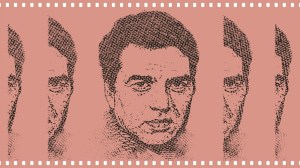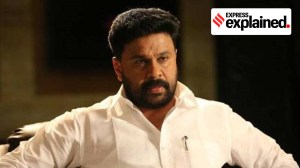Thomas Matthew’s mammoth biography of Ratan Tata forgets the man for the corporate czar
A plethora of details, mostly about the companies Ratan led or was associated with, blot out the man himself. The book, however, has the merit of putting in one place a large amount of information, which while old hat for many in the corporate world, would certainly interest the general reader
 Ratan Tata (Express photo by Mahendra Parikh, Mumbai)
Ratan Tata (Express photo by Mahendra Parikh, Mumbai)Thomas Matthew’s biography of Ratan Tata, which entails a marathon trudge from cradle to grave (well almost) is at 650-plus pages (sans notes and index), at least 200 pages too long. Size in itself is not a deterrent if the book is engagingly written, but shorter attention spans mean that these doorstop biographies (which this reviewer himself is guilty of writing) can start to seem like a looming threat rather than a delicious promise. Exhaustive, in such cases, becomes exhausting.
To be entirely fresh, each new biography must create a template of its own. The tidily chronological, cradle-to-grave biography, may well serve a purpose as a sort of magnified curriculum vitae, but it will always struggle to convey the real personality of its subject. Facts matter, but of equal importance is how they are set out. This is something Matthew could have done well to keep in mind.
The book successfully traces the long arc of Ratan’s life and career: Ratan’s lonely childhood (his parents Naval and Soonoo divorced), his schooling in Bombay where Zubin Mehta was a friend, his education in Cornell (which is one of the more interesting parts of the book), his joining Tatas after his return to India, and stints in NELCO and Empress Mills, are all covered in detail. This is a well-researched book, and all the important corporate milestones receive detailed attention: Ratan’s appointment as chairman, his taming the so-called satraps, his strategic plans, drive to globalisation, Indica and Nano, and high-profile overseas acquisitions like Tetley, Corus and Jaguar Land Rover. There is also a detailed account of the Tata-Mistry spat and its aftermath.
The early part of Ratan’s life is interesting with Matthew telling us about his days in Cornell. He also tells us about his relationship with Carolyn Emmons, the daughter of Frederick Emmons of the architecture firm Jones & Emmons. It could have become something more serious but Ratan returned to India and Carolyn regretted not going to India to work on her relationship with Ratan. The author also deserves to be congratulated for his diligence in placing before the reader a detailed genealogy which tells us that Ratan was the only Tata chairman to be related to the founder, Jamsetji Tata, from both the paternal and distaff side.
Written in lucid prose for the most part, there are parts which are clunky with some awkward phrases. The publisher has done the author no favours. The editing is shoddy (“Ratan was not ‘cowered’” instead of ‘cowed’, which I encountered at least twice, being only one example). The end notes, accessed through a QR code, are sketchy at best, given that there are sentences and phrases within quotes in almost every paragraph. Another big minus is the lack of an index.
A plethora of details, mostly about the companies Ratan led or was associated with, blot out the man himself. The book, however, has the merit of putting in one place a large amount of information, which while old hat for many in the corporate world, would certainly interest the general reader. This part of the book reads more like a long and detailed compendium with Matthew telling us in agonising detail what Ratan did in each of the major companies of the group. Strangely, he does not name national publications (‘a national daily’) but does not fight shy of naming foreign magazines and newspapers.
In an age where almost everything is to be had online, one can hardly expect readers to plough through a book composed mainly of Gradgrindian facts, most of them old. There were many years in Ratan’s life, and a lot of ‘life’ in those years, but Matthew’s bald narration of facts fails to bring out any of the drama. A good biography is much more than a mere assemblage of facts — it is a work of art. Biography is dull if it is just dates and facts: ultimately, it must cover emotions and psychology. Narrative interest, drama and pacing are all important. Matthew comes up short on the last two, and the book ends up as a jerky bundle of facts: almost all of the book’s 35 chapters can be read as standalone chapters.
Strangely, there is no mention of Ratan’s 10-year-old relationship with fellow animal lover, Shantanu Naidu, the general manager in his office, who even found a place in his will. Naidu helped set up Ratan’s Instagram profile and the latter used it to share a picture of him in his 20s using the popular hashtag ‘Throwback Thursday’ which had the internet buzzing. Naidu even wrote a book chronicling their touching intergenerational relationship. Surely, this was something too important to ignore completely.
 Thomas Matthew’s biography of Ratan Tata (Amazon.in)
Thomas Matthew’s biography of Ratan Tata (Amazon.in)
The admiring tone of the book throughout jars. Biographies become more neutral with the passage of time and as new material becomes available. Also, what Virginia Woolf called the ‘widows and friends’ problem no longer exists: time rates all achievements at their proper worth. In Matthew’s defence it can be said that Ratan was still alive when the book was written. Since he intended it to be an authorised biography, presumably he had little choice, but one suspects Matthew’s own biographical intentions were sufficiently censored. In the end, for reasons best known to him, Ratan did not authorise even this sanitised account.
Matthew has shown us the corporate czar in great detail; we would have liked to see more of the man as well. Given the unrestricted access to his subject, and presumably many private and official papers, he appears to have squandered a golden opportunity. The reader manages to get momentary glimpses of Ratan, the man, while reading a book which is for the most part a workmanlike but vapid account of the Tata Group when Ratan was at its helm.
Bakhtiar K Dadabhoy is the author of Zubin Mehta: A Musical Journey, the biography of the music maestro
- 01
- 02
- 03
- 04
- 05































